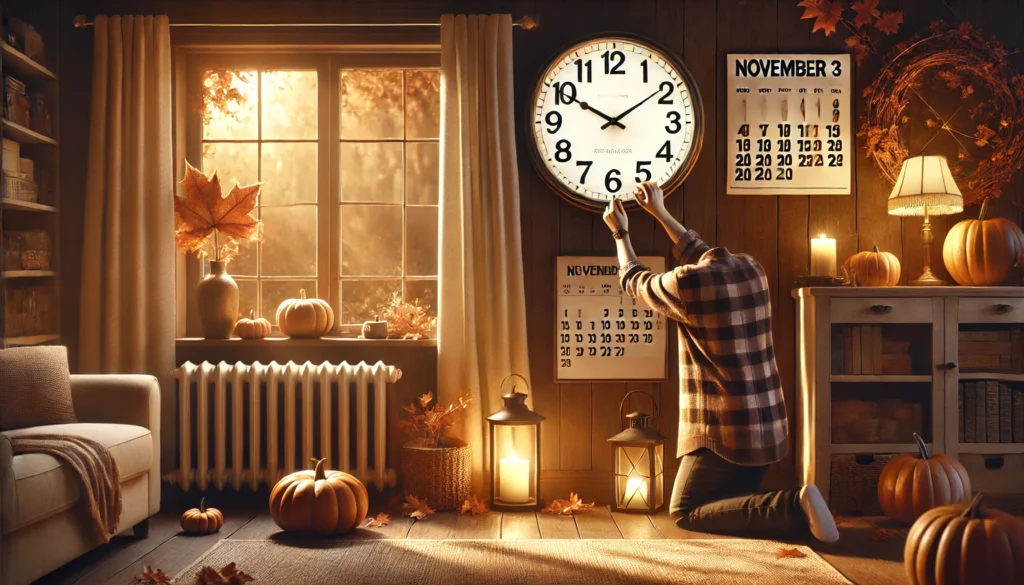
As we approach the end of Daylight Savings Time in 2024, many people are preparing to adjust their clocks and enjoy an extra hour of sleep. This guide covers all the essential information about the time change, including when Daylight Savings ends, what to expect with the hour change, and tips for adjusting to the shift.
When Does Daylight Savings Time End in 2024?
The end of Daylight Savings Time in 2024 falls on Sunday, November 3. This annual fall time change means clocks will “fall back” one hour, transitioning from Daylight Savings Time (DST) back to Standard Time. This shift typically occurs at 2:00 a.m., at which point clocks are set back to 1:00 a.m.
Key Questions About the 2024 Time Change
What Time Does the Time Change?
- The official time change happens at 2:00 a.m. local time on Sunday, November 3. Clocks will be turned back one hour, giving most people an extra hour of sleep that night.
Do We Gain or Lose an Hour?
- In the fall, we gain an hour, which means an extra hour of sleep on the night of November 3. Conversely, in the spring, clocks “spring forward,” and we lose an hour.
Is Daylight Savings Tonight?
- If today is Saturday, November 2, yes, the time change occurs tonight. Be ready to set your clocks back before you go to bed to avoid any confusion in the morning.
What Happens to the Time in Different U.S. Time Zones?
The time change affects every time zone in the U.S. Here’s what it means in a few major cities:
- California (Pacific Time): Clocks will fall back from 2:00 a.m. to 1:00 a.m., marking the shift back to Standard Time.
- Chicago (Central Time): The time will change from 2:00 a.m. to 1:00 a.m., giving Chicagoans an extra hour of sleep.
- New York (Eastern Time): Clocks will revert from 2:00 a.m. to 1:00 a.m., ending Daylight Savings.
Why Do We Have Daylight Savings Time?
Daylight Savings Time was first introduced to maximize daylight during the summer months, allowing for more evening light and conserving energy. While some states, such as Arizona and Hawaii, do not observe DST, the majority of the U.S. participates in the biannual time changes. The “spring forward, fall back” concept helps make use of daylight hours, but there’s ongoing debate over whether to keep DST or switch to Standard Time year-round.
How to Prepare for the Fall Back Time Change
The “fall back” time change might feel easier than the spring adjustment since we gain an hour, but it can still affect sleep patterns and routines. Here are a few tips:
Set Clocks the Night Before: To avoid any surprises in the morning, set your clocks back before going to bed on Saturday, November 2.
Adjust Gradually: If you’re sensitive to time changes, try going to bed and waking up 15 minutes earlier in the days leading up to the change.
Get Morning Sunlight: Exposure to natural light in the morning can help your body adjust to the new time, so consider a morning walk or letting sunlight into your space.
Prioritize Sleep Hygiene: Stick to a consistent bedtime routine and avoid screens close to bedtime. The “fall back” adjustment is usually smoother, but prioritizing good sleep habits is always helpful.
Common Questions About the 2024 Time Change
Has Daylight Savings Ended Already?
- Daylight Savings Time will officially end on November 3, 2024. After this date, we will be on Standard Time until March 2025.
Do We Change the Clocks Twice in 2024?
- Yes. Clocks “sprung forward” on March 10, 2024, and will “fall back” on November 3, 2024.
When Will the Next Time Change Be?
- After the clocks are set back on November 3, 2024, the next Daylight Savings Time change will occur on March 9, 2025.
Important Reminders
- Device Clocks: Smartphones, computers, and other devices usually adjust to time changes automatically, but it’s wise to double-check.
- Non-Digital Clocks: Remember to manually set back wall clocks, car clocks, and any other devices that don’t automatically adjust.
Conclusion: Adjusting to Standard Time
Daylight Savings Time will end soon, and we’ll transition back to Standard Time on November 3, 2024. This clock change gives us an extra hour, marking the end of summer’s extended daylight and the beginning of winter’s shorter days. Whether you’re in California, Chicago, or anywhere in the U.S., be sure to “fall back” an hour and enjoy the extra sleep!
